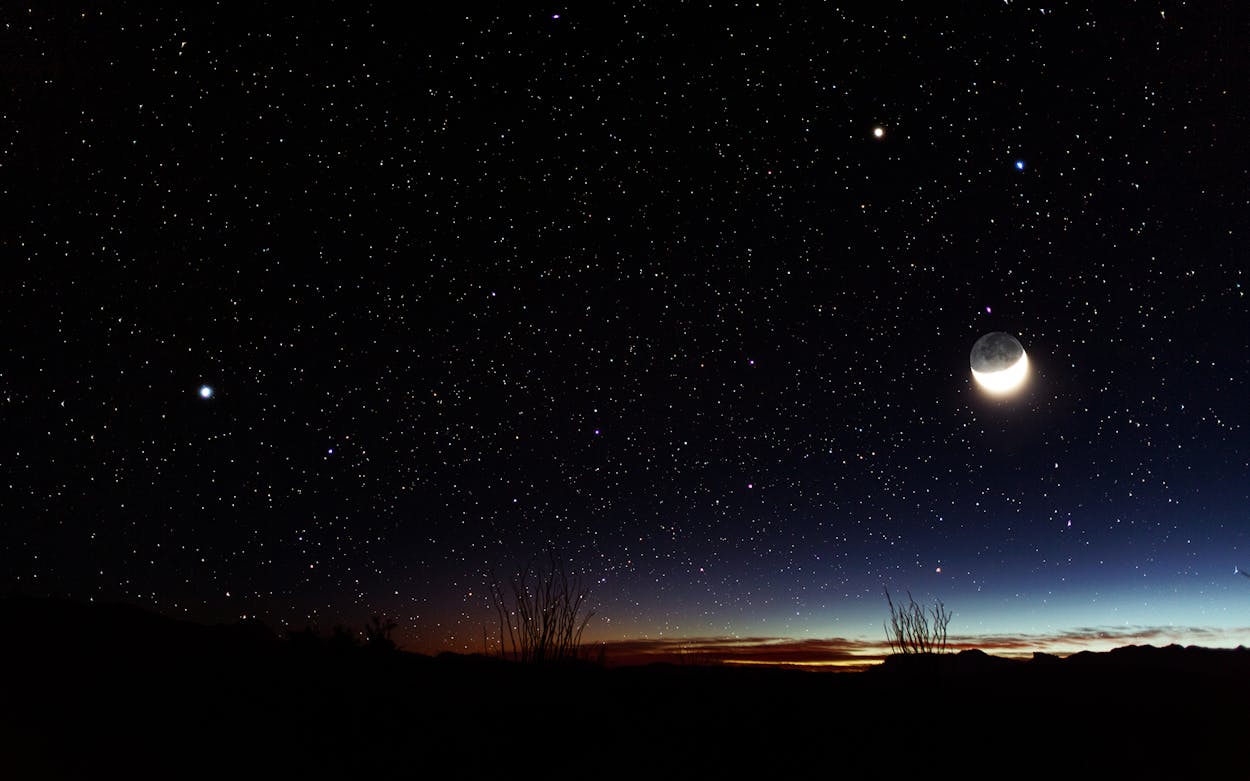“The stars at night are big and bright, but if our cities overwhelm that light, we won’t see that,” says John Barentine, a program manager at the International Dark-Sky Association, a nonprofit dedicated to preserving night skies by combating light pollution. Barentine, who lived in Austin for seven years before moving to Arizona to work with the IDA, says he reminds Texans about the lyrics of “Deep in the Heart of Texas” to point out how integral the night sky is to the state’s folklore and culture. Unfortunately, most of us don’t see those bright stars: for 99 percent of residents in the U.S. and Europe, the night sky is obfuscated by light pollution.
As the effects of artificial light increase, so do the efforts of dark sky advocates. Earlier this month, the IDA designated Big Bend Ranch State Park as an International Dark Sky Park. Part of the Texas Park and Wildlife’s Dark Skies Program, a partnership with the IDA and McDonald Observatory to preserve the parks’ night skies, BBRSP is the fourth state park with the dark sky designation, joining Copper Breaks State Park, Enchanted Rock State Park, and South Llano River State Park. (Big Bend National Park also has the designation.) On the Bortle Scale, which rates how clearly the night sky can be viewed, BBRSP is the only Texas state park to score a one, the clearest rating.
To get the designation for BBRSP, park interpreter Amber Harrison spent a year reaching out to neighboring communities, counting light fixtures, and traversing 315,000 acres in darkness to measure light quality. Harrison, who works at the park’s Barton Warnock Visitor Center, was prompted to action after learning about light pollution at the McDonald Observatory in 2015. “That’s what really piqued my interest,” she says. “It’s kind of one of those things that once you see it, you can’t unsee it.”
The application required a bit more work than providing standard maps and background information on the park: Harrison also had to complete a “Sky Quality Survey” of BBRSP, providing clear evidence of just how dark an area’s skies are. “It’s one thing just to say, ‘Oh, we’re really dark,’” Harrison says. But to prove it, Harrison had to take it a step further.
“On a moonless night, we went to thirteen locations throughout the 315,000 acres of the park and took dark sky readings,” Harrison said. With the help of a device that detects the amount of light pollution in an area, Harrison spent a very dark night mapping out and documenting the readings. Tim Gibbs, the park’s archeologist, accompanied her through the dark roads, mostly as a safety precaution while traveling through the poorly lit areas of the park.
Harrison also received assistance from Bill Wren, special assistant to the superintendent at the McDonald Observatory in Fort Davis, who used new technology developed by the National Park Service called “All-Sky Photometry” to take pictures in the interior of the park. “Basically what the image shows you is the amount of light pollution in your surrounding areas,” Harrison says. “So through that imaging, we were able to demonstrate that we’ve got very little light pollution, and where the light pollution that we do have is coming from.”
Another major part of the application was creating an inventory of every single light fixture in the park in order to show that the lights would meet the IDA’s standards. To do so, Harrison installed all the lights around the Barton Warnock Visitor Center, took a picture, and removed the excess lights, demonstrating how the park had adjusted light use to aid visitors without contributing to light pollution.
The application also involved outreach to neighboring communities, such as Marfa, Alpine, and Presidio, for letters of support. “Not only is the designation relevant to the park, but it’s very relevant to the surrounding communities, because of course light pollution doesn’t stay within the boundaries of the park,” Harrison says. As a park interpreter, she helped educate visitors and nearby communities about the importance of preserving dark skies through star parties and lighting demonstrations. Now that the park has received the dark sky park designation, that programming and education will continue as part of its commitment to advocate for the reduction of light pollution.
The designation is the latest step to protect the dark West Texas sky, following ordinances regulating nighttime artificial lighting in every city in the Big Bend area, festivals celebrating the night sky in West Texas, and the McDonald Observatory’s Dark Skies Initiative, led by Wren, which works with surrounding communities and businesses to reduce light pollution. Wren says the observatory, which has one of the largest telescopes on Earth, has “historically enjoyed the darkest night skies of any major observatory in the world,” although recent activity from oil rigs in the Permian Basin has begun to affect visibility at the observatory. Wren has been working with oil companies to help them adopt better lighting practices.
“We’re trying to promote lighting for the oil and gas activities that is a win-win situation,” Wren says. “It actually improves visibility and increases worker safety for people in the oil field at night and it helps keeps the skies dark for McDonald Observatory.”
In addition to preserving natural ecosystems and human health, maintaining dark skies also has the economic benefit of boosting tourism to West Texas. Laird Considine, the Barton Warnock Visitor Center office manager, says that the park’s dark sky designation has already led to an increase of visitors, with eager calls from dark sky enthusiasts as far away as Seattle. Considine describes the clear night sky as “a natural resource that’s slowly being eliminated.” Now that the BBRSP has the dark sky designation, he expects that maintaining that resource—and preserving the night sky for future generations—will be a source of pride for West Texas.








